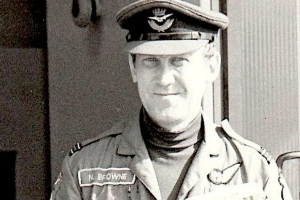Norman Browne - In Memoriam
The following is a copy of the Obituary to Squadron Leader Norman Browne
that was published in the Daily Telegraph on 28 August 2025. The original
article may be read in the Daily Telegraph Online at the following link:
Belfast-born Squadron Leader Norman Browne, who recently died aged 77, was a key figure in the first Gulf War. He was awarded the Distinguished Flying Cross (DFC) for leading operations to drop laser-guided bombs on strategic targets in Iraq.
who recently died aged 77, was a key figure in the first Gulf War. He was awarded the Distinguished Flying Cross (DFC) for leading operations to drop laser-guided bombs on strategic targets in Iraq.
After leaving Grosvenor High School, he joined the RAF and trained as a navigator. His first assignment was to the Fleet Air Arm where he flew in the Sea Vixen all-weather fighter from the aircraft carriers Hermes and Eagle. After two years, he returned to the RAF and spent the next six years on the Phantom air defence fighter based at Leuchars in Scotland. For five of those years, he was the navigator in the RAF’s Phantom display aircraft.
In 1979, the RAF decided to commemorate the 60th anniversary of the first crossing of the Atlantic in 1919 by John Alcock and Arthur Brown. A Phantom was chosen for the flight and an aircraft was painted in a special commemorative scheme. The pilot selected was Squadron Leader Tony Alcock (a nephew of John Alcock). Browne was selected to be the navigator. The aircraft took off from Goose Bay in Labrador on June 21, 1979, was refuelled in mid-air by RAF Victor tankers and landed at Greenham Common airfield after a record-breaking flight of five hours and 40 minutes.
After converting to the Buccaneer in 1979, he was posted to Germany. It was during this tour of duty that the RAF procured, from the US, the Paveway/Pavespike precision laser-guided bomb system.
Pavespike was an electro-optical laser designator-targeting pod mounted on the port wing of the Buccaneer. It was controlled by the navigator who ‘marked’ the target before firing the laser as the Paveway bombs had been released. The bombs then homed to the target with great accuracy. Browne led a series of successful trials, and the system was adopted by the Buccaneer maritime wing at Lossiemouth.
When war broke out in Iraq in January 1991, the RAF’s Tornado bombing force ceased its low-level bombing operations in favour of operating at higher levels. To improve accuracy, a force of Buccaneers was deployed to the region on January 29.








